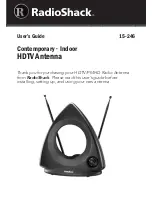
Simulating radar objects
R&S
®
QAT100
20
User Manual 1179.3073.02 ─ 02
5
Simulating radar objects
The R&S
QAT is an advanced antenna array that you can use in combination with a
radar echo generator to simulate radar objects over-the-air. Because the R&S
QAT has
independent antennas, it is possible to realistically simulate multiple moving radar
objects in a single test setup. Thus, you can, for example, test radar based autono-
mous driving functions.
In a typical setup, the R&S
QAT is the frontend that receives and sends the radar sig-
nals. The radar echo generator, for example the R&S
AREG800A, is the backend that
generates the radar echoes and controls the R&S
QAT.
The typical workflow between the two devices goes like this:
1. The R&S
QAT receives a signal from the DUT (radar sensor).
2. The R&S
QAT divides the signal by four and downconverts the signal to an inter-
mediate frequency (IF).
3. The R&S
QAT forwards the IF to the radar echo generator.
4. The radar echo generator delays and attenuates the IF.
5. The radar echo generator sends the delayed IF to the R&S
QAT.
6. The R&S
QAT upconverts and multiplies the IF.
7. The R&S
QAT routes the signal to one or more of the 96 transmit antennas.
8. The R&S
QAT transmits the signal to the DUT.
9. The delayed signal travels back to the radar sensor via the air interface and thus
tricks the sensor into detecting the artificial object.
Radar
echo
generator
R&S QAT
DUT
Figure 5-1: Basic test setup for using a R&S
QAT
The base variant of the R&S
QAT contains one line of antennas. The antenna line has
five receive antennas and 96 transmit antennas. The antennas in turn belong to one of
four antenna segments, which makes one receive antenna and 24 transmit antennas in
each segment. An additional independent receive antenna is located in the center of
















































